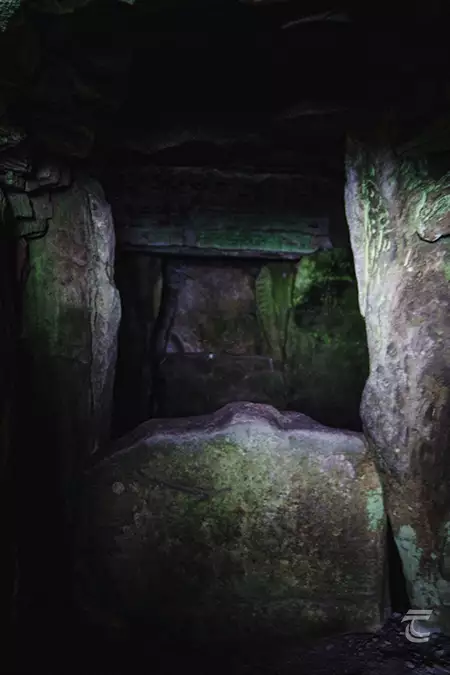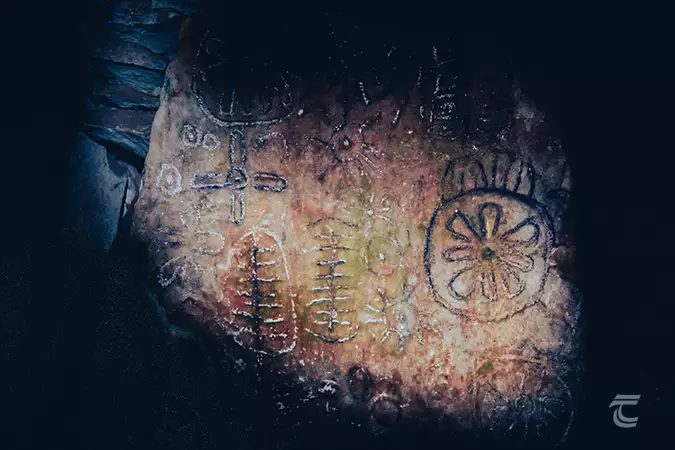Loughcrew Cairns
Loughcrew Cairns is a passage tomb cemetery located near the village of Oldcastle in County Meath. The most striking features of the archaeological landscape of Loughcrew are the three large cairns that dominate the summit of three steep hills, Patrickstown, Carnbane West and Carnbane East. The most visited is Carnbane East that is summited by Cairn T, which acts as the focal point of the whole cemetery. The tombs on Carnbane West are on private land and are currently inaccessible to visitors.
On the summit of Carnbane East, Cairn T is surrounded by a number of smaller tombs, it is thought to date to around c.3000 BC. The large cairn measures around 35 metres (115 ft) in diameter and this passage tomb has a cruciform-shaped chamber and some of the finest examples of Neolithic art in Ireland. If you are lucky enough to visit Loughcrew during the autumn or spring equinox, you may witness sunlight entering the chamber to illuminate the inside of the tomb (cloud cover permitting).
Loughcrew is one of the most rewarding sites to visit in Ireland, and a true must-see for anyone who visits the Boyne Valley. In comparison to Newgrange, Loughcrew is less frequently visited, and as such it can offer perhaps a more intimate experience with the Neolithic passage-tomb builders. There are free guided tours by OPW staff in the summer months. At other times of the year, the key must be collected from Loughcrew Gardens (a deposit and identification are required). However, unfortunately structural problems at Cairn T has led to this tomb being closed for periods of time. We hope it will be reopened in the near future, though there is no published timeline on this at present. Even if you do find the interior of the tomb locked, the site is certainly well worth the walk for the spectacular views and impressive concentration of Neolithic monuments.
For practical information about visiting this site Click Here

Aerial view of Cairn T and the satellite tombs on Carnbane East • Meath
Visiting the Loughcrew Cairns

Megalithic art in Cairn T • Meath
The interior of Cairn T is currently inaccessible, but here is a short description based on previous visits. It is fair to say that entering Cairn T itself is a heady, almost transformative, experience. From crossing the liminal threshold and crouching to enter you see that the passageway is lined with large upright stones, known as orthostats, that display intricate carvings of spirals, lines, lozenges, zigzags, circles and cup marks. When you enter the chamber the roof height increases as does the complexity of the megalithic art. Three recesses serve as the key burial locations, with the westernmost one having the stunning backstone, known as the Equinox Stone as it is beautifully illuminated during the vernal equinox. There has been much speculation about meaning of megalithic art, but this stone more than any other seems to communicate something of the natural world to us, with what look like solar symbols and boat-like shapes. This is my personal favourite example of megalithic art in Ireland.
The Hag’s Chair is one of the kerbstones that surround Cairn T; it is also decorated with megalithic art but unfortunately the carvings are very difficult to make out today, though you may notice some near the base if the light is strong enough. The cross inscribed on the seat is clearer. It possibly represents the use of the stone as a Mass Rock during penal times. It was also thought to have been used as a ceremonial or inauguration chair during the early medieval period.
The Irish name of Loughcrew, Slieve na Calliagh is thought to derive from Sliabh na Caillí, ‘The Hill of the Witch’. Folklore has it that the monuments at Loughcrew were formed when a witch called An Cailleach Bhéara was challenged to drop an apron full of stones on each of the three Loughcrew peaks: if she succeeded she would be proclaimed the ruler of all Ireland. She was successful on the first two peaks, but missed the third and fell to her death.
For more information on Ireland’s passage tombs check out this chat with Dr. Jessica Smyth on Amplify Archaeology Podcast.

Megalithic art in Cairn T • Meath
Upper left: approaching Cairn T • Lower left: the so-called ‘Equinox Stone’ in Cairn T • Right: down the passageway of Cairn T
Top: approaching Cairn T • Middle: down the passageway of Cairn T • Bottom: the so-called ‘Equinox Stone’ in Cairn T


